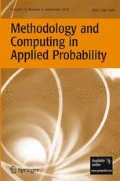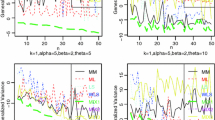Abstract
In this paper we introduce the expectile order, defined by X ≤ e Y if e α (X) ≤e α (Y) for each α ∈ (0, 1), where e α denotes the α-expectile. We show that the expectile order is equivalent to the pointwise ordering of the Omega ratios, and we derive several necessary and sufficient conditions. In the case of equal means, the expectile order can be easily characterized by means of the stop-loss transform; in the more general case of different means we provide some sufficient conditions. In contrast with the more common stochastic orders such as ≤ s t and ≤ c x , the expectile order is not generated by a class of utility functions and is not closed with respect to convolutions. As an illustration, we compare the ≤ s t , ≤ i c x and ≤ e orders in the family of Lomax distributions and compare Lomax distributions fitted to real world data of natural disasters in the U.S. caused by different sources of weather risk like storms or floods.
Similar content being viewed by others
References
Artzner P, Delbaen F, Eber J-M, Heath D (1999) Coherent measures of risk. Math Financ 9:203–228
Azzalini A (1985) A class of distribution which includes the normal ones. Scand J Stat 12:171–178
Bäuerle N, Müller A (2006) Stochastic Orders and Risk Measures: Consistency and Bounds. Insurance: Mathematics and Economics 38:132–148
Bellini F (2012) Isotonicity results for generalized quantiles. Statistics and Probability Letters 82:2017–2024
Bellini F, Bignozzi V (2015) On elicitable risk measures. Quant Finan 15:725–733
Bellini F, Klar B, Müller A, Rosazza Gianin E (2014) Generalized quantiles as risk measures. Insurance: Mathematics and Economics 54:41–48
Blasi F, Scarlatti S (2012) From Normal vs Skew-Normal Portfolios: FSD and SSD Rules. Journal of Mathematical Finance 2:90–95
Eilers PHC (2013) Discussion: the beauty of expectiles. Stat Model 13:317–322
Farooq M, Steinwart I (2015) An SVM-like Approach for Expectile Regression. arXiv:1507.03887
Giles DE, Feng H, Godwin RT (2013) On the Bias of the Maximum Likelihood Estimator for the Two-Parameter Lomax Distribution. Communications in Statistics - Theory and Methods 42:1934–1950
Jones MC (1994) Expectiles and M-quantiles are quantiles. Statistics and Probability Letters 20:149–153
Keating C, Shadwick WF (2002) A Universal Performance Measure. The Finance Development Centre, London
Keating C, Shadwick WF (2002) An Introduction to Omega. The Finance Development Centre, London
Kneib T (2013) Beyond mean regression. Stat Model 13:275–303
Koenker R (2013) Discussion: Living beyond our means. Stat Model 13:323–333
Lopez-Cabrera B, Schulz F (2014) Forecasting generalized quantiles of electricity demand: A functional data approach. SFB 649 Discussion Paper, No. 2014-030. Humboldt University, Berlin
Müller A (1996) Ordering of risks: A comparative study via stop-loss transforms. Insurance: Mathematics and Economics 17:215–222
Müller A (1997) Stochastic Orders generated by Integrals: A Unified Study. Adv Appl Probab 29:414–428
Müller A, Stoyan D (2002) Comparison Methods for Stochastic Models and Risks. John Wiley & Sons Ltd., Chichester
Newey K, Powell J (1987) Asymmetric least squares estimation and testing. Econometrica 55:819–847
NOAA (2016) National Centers for Environmental Information (NCEI) U.S. Billion-Dollar Weather and Climate Disasters. https://www.ncdc.noaa.gov/billions/
Pickands J (1975) Statistical inference using extreme order statistics. Ann Stat 3:119–131
Remillard B (2013) Statistical Methods for Financial Engineering, Chapman and Hall/CRC
Schnabel SK, Eilers PHC (2009) An analysis of life expectancy and economic production using expectile frontier zones. Demogr Res 21:109–134
Schulze-Waltrup L, Sobotka F, Kneib T, Kauermann G (2015) Expectile and quantile regression: David and Goliath?. Stat Model 15:433–456
Shaked M, Shantikumar JG (2007) Stochastic Orders, Springer Series in Statistics
Whitmore GA (1970) Third-Degree Stochastic Dominance. American Economic Review 60:457–459
Ziegel JF (2016) Coherence and elicitability. Math Financ 26:901–918
Author information
Authors and Affiliations
Corresponding author
Additional information
In memory of Moshe Shaked
Rights and permissions
About this article
Cite this article
Bellini, F., Klar, B. & Müller, A. Expectiles, Omega Ratios and Stochastic Ordering. Methodol Comput Appl Probab 20, 855–873 (2018). https://doi.org/10.1007/s11009-016-9527-2
Received:
Revised:
Accepted:
Published:
Issue Date:
DOI: https://doi.org/10.1007/s11009-016-9527-2
Keywords
- Expectile order
- Omega ratio
- Stop-loss transform
- Third-order stochastic dominance
- Skew-normal distribution
- Lomax distribution



